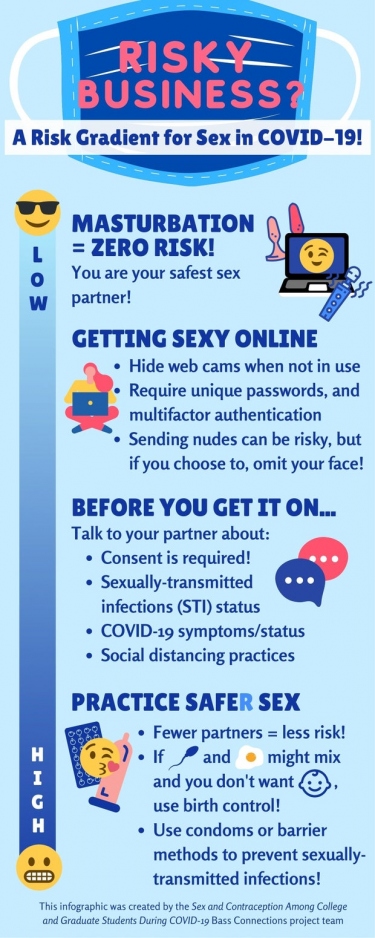Sexual Health During a Pandemic
Project Team

This project team was part of our COVID-19 pop-up theme, which tackled research related to the COVID-19 pandemic.
The COVID-19 pandemic has prompted marked changes in daily life to comply with social distancing guidelines. Although most focus has been on changes related to large-scale social activities (work, school, shopping, dining out, etc.), it is likely that the pandemic has also affected sexual habits, activities, and health practices, especially outside of partnered relationships, in ways that could affect both reproductive health and COVID-19 transmission.
For young adults pursuing post-high school education, cancellation of in-person classes, closure of many campuses, and reduced access to in-person healthcare may put those who are sexually active at higher risk of unplanned pregnancy or sexually transmitted infections. There are existing racial and ethnic disparities within this group in contraceptive access and use and sexually transmitted infection incidence, which may be exacerbated by the marked racial and ethnic disparities in the impact of COVID-19.
Our Bass Connections team sought to understand how the COVID-19 pandemic had provoked changes in sexual health and sexual activity among college and graduate students in addition to contraception use and access. We were also interested in assessing how many two- and four-year schools across the nation were prepared to offer their students telemedicine services given the new socially distanced environment.
We thus formulated the following research questions:
- How has access to sexual health resources including contraception been affected, especially since many schools had at least some students primarily online?
- In this new socially distanced environment, how many schools across the country are equipped to offer their students socially distanced healthcare or telemedicine?
To answer these research questions, we split our team into three smaller teams:
- The survey team designed and conducted a survey of North Carolina college and graduate students about sexual health and contraceptive access.
- The website team used content analysis methodology to analyze availability of student health centers and telehealth at higher education institutions across the U.S.
- The outreach team utilized data collected from both the survey team and website team to partner with Duke student health and neighboring schools to share results.
Preliminary Research Findings
Survey team
Over the course of nine days, the advertisements were displayed 45,054 times (ie., impressions), viewed by 28,719 Instagram users (ie., reach), and clicked by 2,542 users (ie., unique link clicks). 996 of 1,002 eligible participants completed the survey for a 99.4% completion rate.
- Students reported continued access to their preferred contraception, including through telehealth and through student health
- Students reported an increase in the frequency of using online/video platforms for dating and sex
- AND students continued to have in-person sexual encounters
- Majority of respondents female-identifying and from Duke, UNC-CH, and NCSU
- Majority of students felt that their peers were underestimating the risks of COVID-19
Website team
Only 36.8% (n=131) of the total sample (n=364) offers student telehealth services.
Outreach team
The team met with Duke Wellness and representatives from North Carolina State University campus health and the University of North Carolina campus health and are working on a distribution plan.
Sex and Contraception Among College and Graduate Students During COVID-19
Poster by Emily Chen, Lauren Holt, Sydney Morrow, Grace O'Leary, Rachel Proudman, Emily Sen, Andrew Shin and Lucy Zheng (winner, Bass Connections Poster Competition, Judges’ Selection)
Poster by Clarice Hu and Andrew Shin


